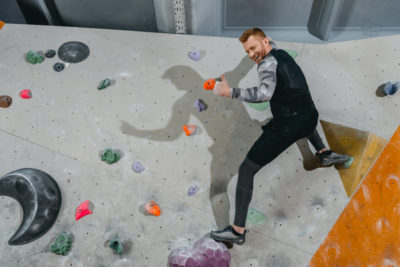Obviously, a strong fear of heights can be a bit of a problem in bouldering. A reasonable fear of heights and falling keeps us safe, but what to do if it is strong enough to stop us from enjoying a great sport?
What are three simple ways to control fear of heights in bouldering? Start with low problems, and take your time with building height into your sessions. Before jumping on a wall, make a habit of briefly relaxing your body and calming your mind. If you find yourself overly anxious while on the wall, take a few slow, deep breaths to center yourself. Keep in mind that real dangers should be mitigated.
Sure, when you’re bouldering you won’t be going anywhere near as high as you would be with traditional rock climbing, but then, you don’t have the reassurance of safety gear either. Being nervous about going too high keeps you safer on the wall, but it becomes a problem when the fear is stronger than your enjoyment of the sport.
1 – Don’t Rush the Vertical
Take your time building up some height in your climbing.
I grew up on sailing ships with very tall masts. One summer I decided to conquer the ratlines and see how far up a mast I could get. When I first started climbing, my heart was pounding at about 15 feet up from the deck. I stayed at this height until my heartbeat was no longer reacting to it, then every afternoon I would climb a rung or two higher. I would just hang onto the ratlines at that height, taking in the view, until it felt normal.
I was doing this just for myself, with no agenda to prove, so there was no time pressure. But in a very short time, two weeks at most, I felt very comfortable running up the rungs to the crow’s nest, a good 40 feet or so off the deck.
A good way to initiate this approach with bouldering is to start with traverse problems, where you are moving horizontally instead of upwards. Traverse problems will get you off the ground and climbing, building strength and skill while allowing you to get comfortable with a certain height before moving up to your next height challenge.
Taking it slow, and not forcing the issue, allows the body and mind to acclimatize to each new height without adding an automatic stress response to the experience.
2 – Associate the Experience with Calm, Not with an Adrenalin Rush
Before jumping on the wall, take a brief moment to relax and feel calm.
When I first started riding behind my husband on his new KYMCO scooter, I made a point of relaxing my body and running the word “calm” through my mind. I needed to do this to override the panic that flooded through me when I got on the bike, due to some bad history with this type of transportation. But the lure of the experience – holding on tight to the man I love, seeing the world flow by with the wind in my face – overrode the reluctance to do the activity.
So I used conscious relaxation as a way of coping with the panic. There was only time for a quick moment before the bike would start rolling. This was nothing like doing extended meditation sessions or going for therapy. We’re talking, at the most, two or three seconds of thinking “calm” and relaxing the muscles.
The funny thing is, after consistently doing this at the beginning of every ride, eventually it got to the point where a sweet, unexpected sense of calm would just come over me the minute my bottom touched the bike seat. To my great surprise, the calm response had become automatic, and I could now focus on enjoying the fun.
So if height is getting in the way of enjoying your bouldering experience, give this approach a try. Consistently, before getting on the wall, take two seconds to physically relax your muscles, and focus your mind on a word like “calm” or “relax”. Feel the calmness through your body for a brief moment. Then step on the first hold, and free yourself to focus on the climbing experience itself.
3 – Breathe Yourself out of the Fear
Deep and slow breathing immediately reduces the stress response. If you find yourself high on a wall in the throes of anxiety over the height, breathe slowly and deeply into your belly, hold the breath for a moment, and let the air out very slowly. Repeat several times until your heart rate slows a bit.
This method is known as diaphragmatic breathing, and it immediately activates the relaxation response. The relaxation response, in turn, improves brain function, and you will be in a better position to think yourself out of your position on the wall.
The Backup Plan: Master Falling Techniques and Know Your Escape Route
Master some basic falling techniques: building up your knowledge of some good falling habits, and occasionally practicing them, will give you more confidence with height on the wall. To learn proper falling techniques, learn from a pro: book some sessions with a climbing gym that has a good training program.
Know your escape route: always study your descent before making a start on a problem. It will go a long way towards reducing anxiety while on the wall if you already have a plan on how you will be coming back down.
Remember that repeatedly jumping down from the wall, even from low heights, will damage your joints over time. Avoid jumping down as much as possible. When you have sent your problem, use a descent route instead of jumping.
Related Questions
Are there any benefits to having height anxiety? Yes. A healthy respect for heights will help to keep you safe. You will be more likely to have a realistic appraisal of your abilities, and to take fewer unnecessary risks. Also, you will be more likely to stay intent on your moves while on the wall. This single-minded focus on the activity is similar to meditation, and has been shown to reduce stress, depression, and general anxiety. For more information, see the link just below.
https://uanews.arizona.edu/story/bouldering-envisioned-new-treatment-depression
Never Mind Heights, What about Social Anxiety in the Gym? If you find that you are not speaking to anyone, session after session, but you are enjoying the solitude, that’s great! Bouldering is more of a solo sport than traditional rock climbing, and this suits some people just fine. However, if after a few sessions you are starting to feel like a social outcast, an excellent way to meet and connect with other new boulderers is to sign up for some group training sessions at the gym where you plan on doing most of your bouldering.

